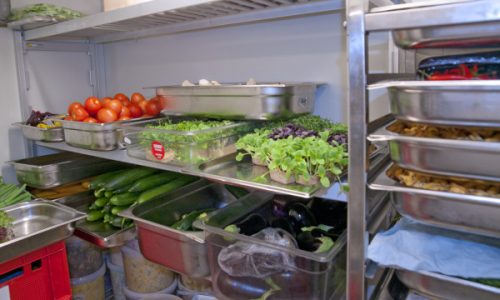Most restaurant managers strive to maintain a clean, safe kitchen environment. To that end, they always try to ensure that cooler temperatures remain in the range required for safe food storage.
But despite their best efforts, those temperatures are frequently out of range.
If that comes as a surprise, just check out the food safety reports in your local newspaper. Our hometown paper, the Atlanta Journal-Constitution, publishes these reports twice per week. More often than not, restaurants that fail their inspection have issues with temperatures inside walk-in coolers, condiment coolers, and prep/handling coolers.
It’s not that restaurant personnel are willfully negligent. In fact, most managers probably assumed the temperatures were fine.
Will your cooler temperatures be in range for your next inspection?
The acceptable window for the cold holding of food is between 33 and 41 degrees Fahrenheit. If temperatures drop below 33 degrees, and the food might freeze. If they rise above 41 degrees, the food might spoil.
The bottom line is that there’s an 8-degree range of acceptable cooler temperatures. Unfortunately, not everyone manages to stay within those parameters.
Just this August, an Atlanta-area Caribbean restaurant failed its health inspection, in part for “chicken and rice that were being kept at improper temperatures.” An inspector also noted “a variety of food storage and temperature issues” at a popular Atlanta brunch spot, which, among other violations, resulted in an inspection failure.
These issues are common, and they usually result from:
- Incorrect display temperatures on or inside cooling equipment
- Faulty thermometers inside cooling equipment
- Lack of technology to indicate how long cooler temperatures have been out of range
- Fudged or inaccurate logbook data that doesn’t alert management to the problem in time to solve it
- Systems or protocol that fail to keep staff accountable and catch temperature issues before they become major problems
Managers are usually surprised to learn that temperatures are out of range because they never realized they were experiencing any of these problems. Sometimes, it’s a simple issue that you can easily fix – cleaning the coil, for instance. Other times, the problem might be more complex. Problems with your compressor fit in that category.
You might not think your restaurant coolers have temperature issues, but how can you be sure? The best way is to embrace technologies that help you avoid most of these problems entirely and resolve others right away – long before the health inspectors show up.
Start monitoring temperatures proactively, not reactively
The reactive way to monitor temperatures is to assume your existing equipment, staff, and procedures result in accurate temperature monitoring. Then, when an inspection reveals them to be out of range, you fix them.
That’s a recipe for brand damage, not to mention compromising the safety of guests.
Here’s the proactive way to monitor temperatures. Invest in technologies that:
- Monitor temperatures around the clock: Powerful sensors should live inside your coolers and constantly monitor temperatures. They’ll transmit data to the cloud, so you can keep constant tabs on all of your cooling equipment.
- Notify you when temperatures are out of range: When something isn’t right, you’re going to hear about it – even when a cooler fails in the middle of the night. If you’ve ever been greeted by soggy boxes in the morning, you know how important this is!
- Account for defrost cycles: What if a cooler is working properly but it’s in the middle of a defrost cycle during a health inspection? Unless you’re using a system that accounts for that, it might look like temperatures are out of range.
Not only will you be more likely to pass your inspection, but you’ll also avoid product loss. How many times have you had to throw food away because cooler temperatures exceeded 41 degrees during the night? If you’re alerted the moment that temperatures re increasing – and you take corrective action immediately – you can often save your food.
ComplianceMate monitors temperatures in real time
Keeping tabs on cooler temperatures is part of a comprehensive HACCP plan, and the ComplianceMate system has you covered for every cooler, everywhere in your kitchen.
There’s no remodeling or drilling required, and you’ll have round-the-clock access to all temperature data from any device, anywhere in the world. Temperatures out of range? You’re going to get an alert. It’s everything you need to have peace of mind that your food is safe.
And the health inspectors? Let’s just say you’re far less likely to appear in the local paper with “unsafe food” hanging around your neck like a scarlet letter.



